Chances are, if you’ve ever wanted to create some kind of visual (e.g., flywheel, pie chart, timeline), then you’ve used Canva.
Canva has quickly replaced established graphic design tools like Photoshop to become the go-to place for non-design-savvy users to create visual content:

SEO played a huge role in its success, as illustrated by these numbers from Ahrefs:
- Domain rating of 92
- 200+ million visitors per month
- 24.1 million backlinks
- 6.3 million organic search keywords, of which 546,000 rank in the first 3 positions in Google SERPs
This post will look at Canva’s SEO strategy and how it has helped the company reach a valuation of $26 billion in 2024. I’ll talk about their landing page tactics, content creation, and overall digital marketing approach.
How Canva Started
Canva’s story kicked off in 2012 when Melanie Perkins, a young Australian entrepreneur, got fed up with how complicated traditional design software like Adobe Photoshop and InDesign were.
She was teaching students how to use these programs and thought, “There’s gotta be an easier way to do this.” That’s when the idea for Canva was born.
Melanie teamed up with her partner Cliff Obrecht and tech whiz Cameron Adams to bring this vision to life. Their goal? Create a design tool that anyone could use, even if they’d never designed anything before. It was a pretty ambitious plan, but they were determined to make it happen.
After a lot of hustle, late nights, and more than a few rejections from investors, they finally launched Canva in 2013. The app took off like wildfire.
People loved how easy it was to create awesome designs without needing a degree in graphic design. From social media posts to presentations, Canva had users covered:
Fast forward to today, and Canva’s become a household name in the design world with millions of daily users. As of March 2024, its valuation stands at $26 billion, which reflects the company’s robust growth and market presence.
Key Takeaway: Canva was born from a desire to simplify design software. Despite initial challenges, the platform launched in 2013 and quickly gained popularity due to its user-friendly approach to design.
Canva’s SEO Mastery: 5 Strategies Behind Its Rapid Growth
Let’s dive into how Canva became the big cheese of the design world. They didn’t just stumble into success — they had some pretty clever tricks up their sleeve. Here are 5 strategies that helped Canva gobble up a huge slice of the design market pie:
1. Solving Problems, Not Selling Tools
Canva nailed it with their job-to-be-done approach. They realized people aren’t looking for a design tool; they’re trying to create a killer business card or a scroll-stopping Instagram ad. So, they built landing pages for every design job imaginable.
Canva created tons of specific landing pages for every design job you can imagine:
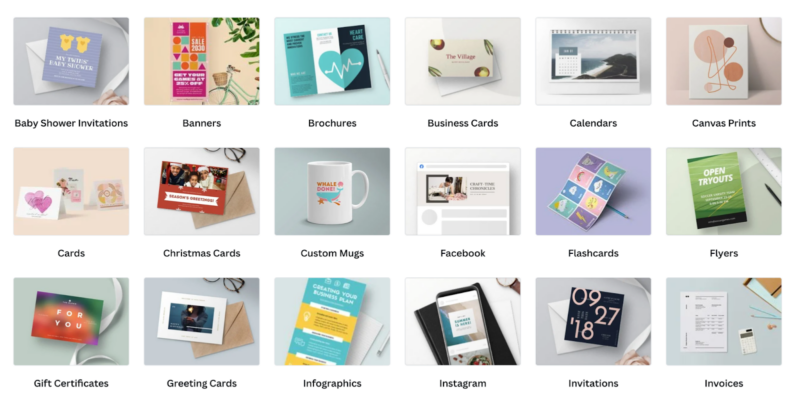
This is a great SEO strategy that I’ve talked about before. Creating landing pages that are tailored to specific areas is an extremely valuable SEO strategy, especially for local marketing.
You can never have too many landing pages. In fact, according to research by HubSpot, businesses with more than 40 landing pages increase conversions by over 500%:
Focused landing pages tend to perform better in terms of conversions. By presenting specific information about an offer without distractions, they keep visitors’ attention on the main goal. This targeted approach often leads to higher conversion rates compared to more general pages with multiple links and diverse information.
2. Getting Super Specific (Like, Really Specific)
Canva didn’t just stop at broad categories. They went deeper and created landing pages for the most niche design needs you can think of. I’m talking about “vintage cat birthday invitation” level specific.
This strategy is like throwing a million fishing lines into the ocean of Google search results. No matter what oddly specific design thing you’re looking for, chances are Canva’s got a hook in the water for it.
Lost your dog? There’s a Canva page for that poster. Planning a beach party? Yep, they’ve got invitation templates ready to go. No matter what template you’re searching for, chances are the first two or three choices in SERPs will be Canva pages:
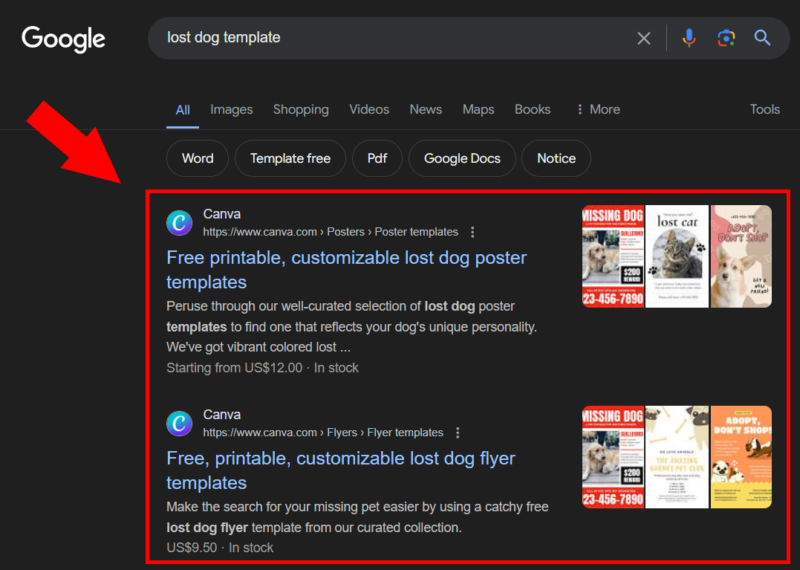
Canva mastered the art of matching user intent. They understood that when you type “make a logo” into Google, you’re not looking for a design lecture — you want a tool for logo design, pronto. So they crafted their content and keywords around what users are trying to achieve, leading to sky-high conversion rates.
3. Turning Users into Teachers (and Marketers)
Canva knows that teaching customers is smart business and a great marketing strategy. Most big software companies do it, and for good reason — it keeps users coming back.
Canva took this idea and ran with it. They built their own learning platform with quality resources, kind of like a mini-Udemy just for design projects.
Here’s how it works: Canva users can take classes to get better at design. But that’s not all — they can also become teachers themselves. Canva calls these super-users “Canvassadors” (cute, right?):
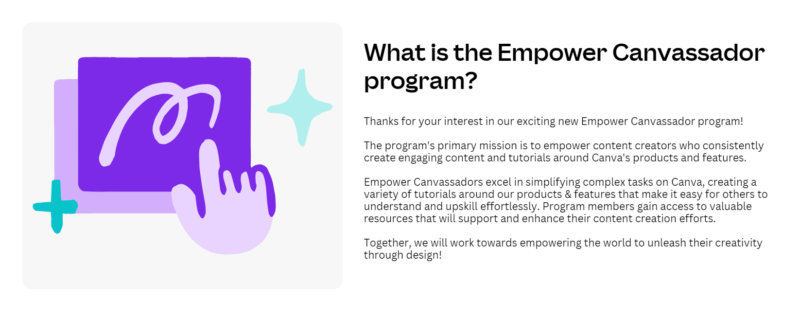
It’s a clever setup. Canvassadors make and sell their own design templates and courses through the Canva Creators program. This brings in new users who want to learn. Then some of these newbies get really good and become Canvassadors too.
It’s like a never-ending cycle of learning and teaching. This isn’t a new trick — other SaaS companies like HubSpot, Salesforce, and Mailchimp do similar things. But Canva’s really nailed it. They’ve turned their users into both students and teachers, and that keeps people hooked on Canva.
4. Strategic Partnerships
Canva cozied up to big names like HubSpot, Buzzsprout, and HP, integrating their tool into these platforms. They’ve made it nearly impossible for anyone doing any design-related project to avoid them:
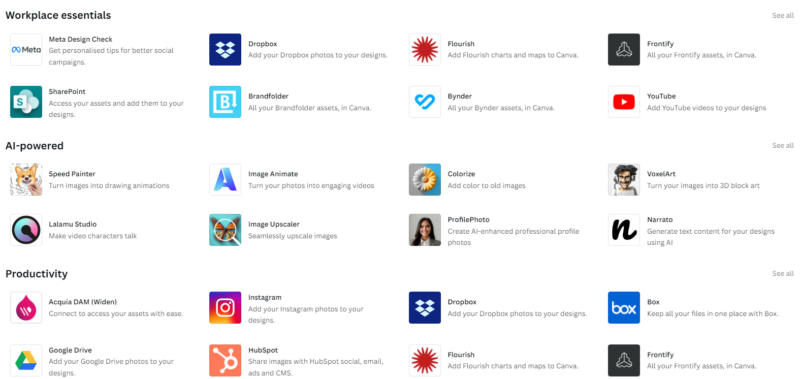
It’s like Canva’s playing a giant game of connect-the-dots across the web. Every integration is another dot connected, making Canva more and more unavoidable for anyone doing anything remotely design-related online.
5. Going Global with Smart Localization
I’ve talked about why localization is a smart tactic before and highlighted how MrBeast used content localization to expand his reach globally. Canva did the same:
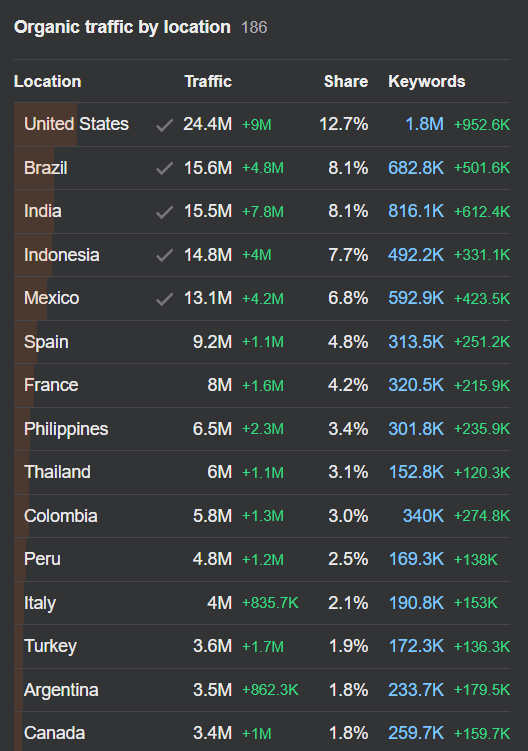
They didn’t just translate their website and call it a day. They dove deep into localization, tailoring their content for different cultures and markets. The brand is now in 190 countries and supports 100+ languages.
Key Takeaway: Canva’s success stems from a multi-faceted SEO strategy that combines hyper-specific landing pages, user-intent matching, community-driven education, strategic partnerships, and global localization.
Final Thoughts on Canva’s SEO Strategy
Canva’s journey from a simple idea to a $26-billion design powerhouse is a testament to the power of identifying and solving a widespread problem. By making design accessible to everyone, Canva didn’t just create a product; they revolutionized an industry.
Their growth strategy, especially their SEO approach, is worth taking notes on. Canva nailed it by focusing on specific user needs, creating targeted content, and expanding globally. The way they’ve built a community through their Canva Creators program shows they understand the value of turning users into advocates. It’s a smart playbook for any business looking to make it big in the digital world.
Canva’s story isn’t just about business success; it’s about democratizing creativity in the digital age. For aspiring entrepreneurs, it’s a great example of how to build something truly useful in today’s market.
Related Video
If you’re ready to level up your digital marketing, Single Grain’s marketing experts can help!👇
For more insights and lessons about marketing, check out our Marketing School podcast on YouTube.








